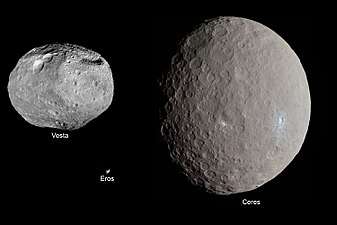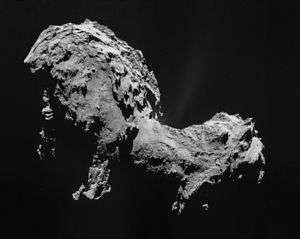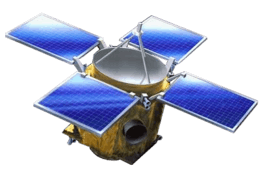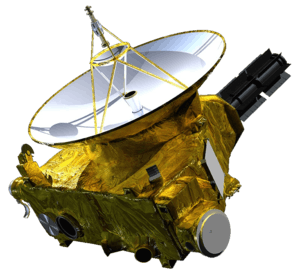AIDA (mission)
| Mission type | Dual asteroid probes |
|---|---|
| Operator | European Space Agency, NASA |
| Website | AIDA study |
| Start of mission | |
| Launch date |
Hera: October 2023 (proposed) DART: July 2021 (may be delayed) |
| Rocket |
Hera: unknown DART: Minotaur V[1] |
| (65803) Didymos[2] orbiter | |
| Spacecraft component | Hera |
| Orbital insertion | September 2026 |
| (65803) Didymos[3] impactor | |
| Spacecraft component | DART |
| Impact date | October 2022 (may be delayed) |
The Asteroid Impact and Deflection Assessment (AIDA) mission is a proposed pair of space probes which would study and demonstrate the kinetic effects of crashing an impactor spacecraft into an asteroid moon. The mission is intended to test whether a spacecraft could successfully deflect an asteroid on a collision course with Earth.[4] The concept proposes two spacecraft: Hera (built by ESA) would orbit the asteroid, and Double Asteroid Redirection Test (DART) (built by NASA) would impact its moon. Besides the observation of the change of orbital parameters of the asteroid moon, the observation of the plume, the crater, and the freshly exposed material will provide unique information for asteroid deflection, science and mining communities.
Initially, Hera's role was to be realized by a much larger spacecraft called Asteroid Impact Mission (AIM).[5] In December 2016 the European Space Agency cancelled the development of the AIM spacecraft after Germany decided to fund the ExoMars project only.[6] NASA has continued on with the development of the DART spacecraft, replacing AIM's role of monitoring the effects of the impact with ground-based telescopes.[7]
As DART is currently planned to launch in 2021, Hera would only arrive at Didymos a few years after DART's impact. To maximize scientific outcome, the AIDA team proposes to delay DART's launch so that Hera will arrive at the asteroid first, enabling it to witness DART's impact.[5] While most of the initial objectives of AIDA would still be met if Hera arrives after DART, as a drawback data from direct observation of the impact and ejecta formation will not be obtained.[5]
Collaboration
The AIDA mission is a joint international collaboration of the European Space Agency (ESA), the German Aerospace Center (DLR), Observatoire de la Côte d'Azur (OCA), NASA, and Johns Hopkins University Applied Physics Laboratory (JHU/APL).[8] The project was formed by joining two separate studies, DART, an asteroid impactor developed by NASA, and a monitoring spacecraft - ESA's Hera (formerly AIM).[8]
The μLidar instrument on board Hera will be provided by a consortium of teams from Portugal, Poland, and Ireland.[2] 11 countries have shown interest in contributing to Hera's 6U CubeSat in the form of seven instrument proposals.[2][9] Two among them, each with the size of 1U will be chosen.[9] Along with monitoring DART's impact, Hera itself may also carry an impactor. As proposed by the Japanese Space Agency, this instrument will be a replica of the Small Carry-on Impactor (SCI), an explosively formed penetrator on board the Hayabusa2 asteroid sample return mission.[5] The SCI would hit the asteroid's moon at a speed lower than that of DART.[2] By performing a secondary impact, a comparison of the effects posed by two collisions of different nature on the same asteroid can be realized, helping validate numerical impact algorithms and scaling laws.[2]
Mission design
AIDA would target 65803 Didymos, a binary asteroid system in which one asteroid is orbited by a smaller one. The primary asteroid is about 800 m (2,600 ft) in diameter; its small satellite is about 150 m (490 ft) in diameter in an orbit about 1.1 km from the primary. Didymos is not an Earth-crossing asteroid, and there is no possibility that the deflection experiment could create an impact hazard.[10]
Under the original proposal, AIM would have launched in October 2020, and DART in July 2021. AIM would have orbited the larger asteroid and study the composition of it and its moon. DART would then impact the moon on October 2022, during a close approach to Earth.[8] AIM would have studied the asteroid's strength, surface physical properties and its internal structure, as well as measure the effect on the asteroid moon's orbit around the larger asteroid. Since the AIM orbiter was cancelled, the effects of the impact by DART will be monitored from ground-based telescopes.
The impact of the 300 kg (660 lb) DART spacecraft at 6.25 km/s will produce a velocity change on the order of 0.4 mm/s, which leads to a significant change in the mutual orbit of these two objects, but only a minimal change in the heliocentric orbit of the system.[1][8][10] AIDA would provide a great benefit obtaining the size of the resulting impact crater in addition to the momentum transfer measurement, as the effects of porosity and strength of the target are needed to calculate the momentum transfer efficiency.[8][10]
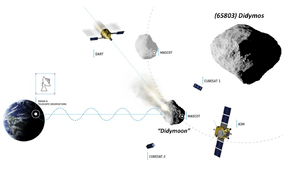
Proposed payload
The notional requirements are:[1][10][5][2]
- Hera
- an asteroid framing camera to obtain information on the dynamics of a binary asteroid and physical characteristics
- a laser altimeter to measure the shapes of the two bodies and constraining the mass of the asteroid's moon
- a CubeSat for spectral imaging that supports the science and technology objectives of Hera and the AIDA mission
- DART
DART is a 300 kg (660 lb) impactor that hosts no scientific payload other than a 20-cm aperture CCD camera to support autonomous guiding to impact the target body through its center.
An optional impactor and high-frequency radar may also be carried by Hera.[2]
The notional requirements for AIM as of 2012 were:[1][10]
- an asteroid lander (based on the German MASCOT heritage) for in-situ measurements
- a thermal infrared imager to discriminate different surface properties like rocks or granular surfaces
- a monostatic high frequency radar to obtain information on the structure of the asteroid's surface
- a bistatic low frequency radar (on the orbiter and on the lander) that allows a view inside the asteroid and obtain data on its inner structure
- two interplanetary CubeSats [11] out of five proposals currently under investigation that support the science and technology objectives of the AIM and AIDA mission
- deep-space optical communication
Status
Both AIM and DART were initially approved for preliminary design in February 2015,[10] but in December 2016 the ESA component, the AIM orbiter was not funded in order to help pay for additional expenses of the ExoMars rover.[6] ExoMars rover has been in development since at least 2005 when over half a billion Euros was authorized for it.[6]
Germany offered to cover 35 million of the 60 million needed for the AIM portion to continue, however, this was not enough to continue development.[7] Nevertheless, NASA has continued with the DART mission to (65803) Didymos, and will measure the effects of the impact from ground-based telescopes.[12][13] Following AIM's cancellation, ESA director Jan Wörner stated his intentions to revive the mission in some form.[12] Etienne Schneider, Luxembourg's deputy prime minister expressed regret at AIM's cancellation, and commented that his country would continue to advocate for the realization of the mission.[14]
As of March 2018, Hera proposal is in Phase B1, where upon the preliminary design is being drawn up. A system requirement review (SRR) is scheduled to be conducted in January 2019, followed by a preliminary design review (PDR) in May 2020.[2]
See also
- Asteroid impact avoidance
- B612 Foundation
- Don Quijote, AIDA's predecessor proposal
- The Spaceguard Foundation
References
- 1 2 3 4 Cheng, A.F.; Michel, P.; Reed, C.; Galvez, A.; Carnelli, I. (2012). DART: Double Asteroid Redirection Test (PDF). European Planetary Science Congress 2012. EPSC Abstracts.
- 1 2 3 4 5 6 7 8 Carnelli, Ian (11 October 2017). "The Hera Mission Study" (PDF). ESA. Retrieved 2018-06-11.
- ↑ "AIDA study". ESA. 19 December 2012. Archived from the original on 20 October 2014. Retrieved 2014-09-19.
- ↑ AIDA mission rationale Archived May 11, 2015, at the Wayback Machine.. ESA, 25 May 2012.
- 1 2 3 4 5 Michel, Patrick; Kueppers, Michael; Sierks, Holger; Carnelli, Ian (26 April 2017). "European component of the AIDA mission to a binary asteroid: Characterization and interpretation of the impact of the DART mission". Advances in Space Research (Article). Elsevier (published 18 December 2017). doi:10.1016/j.asr.2017.12.020. Retrieved 2018-06-11.
- 1 2 3 ExoMars Rover Gets Funding Despite Schiaparelli Mars Lander Crash. Alixandra Caole Vila, Nature World News. 7 December 2016.
- 1 2 NASA presses ahead with asteroid mission despite ESA funding decision. Jeff Foust, Space News. 13 December 2016
- 1 2 3 4 5 Asteroid Impact & Deflection Assessment (AIDA) study Archived 2015-06-07 at the Wayback Machine..
- 1 2 Carnelli, Ian (31 January 2018). "Status of AIM/Hera" (PDF). ESA. Retrieved 2018-06-11.
- 1 2 3 4 5 6 "AIDA: Asteroid Impact and Deflection Assessment Mission Under Study at ESA and NASA" (PDF). Observatoire de la Côte d'Azur. February 2015. Retrieved 2015-03-29.
- ↑ Cubesat Companions for ESA's Astroid [sic] Mission. Source: ESA. November 2, 2015.
- 1 2 Foust, Jeff (February 15, 2017). "NASA presses ahead with asteroid mission despite ESA funding decision". SpaceNews. Retrieved 2018-06-11.
- ↑ Andone, Dakin (July 25, 2017). "NASA unveils plan to test asteroid defense technique". CNN. Retrieved July 25, 2017.
- ↑ Henry, Caleb (February 15, 2017). "Luxembourgian minister unwilling to let ESA asteroid mission die without a fight". SpaceNews. Retrieved 2018-06-10.
External links
- ESA Hera page
- Sciency Words: Didymoon
- Video: 5 min presentation of AIDA, at YouTube.

